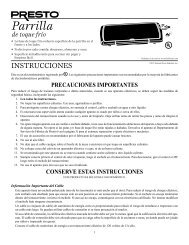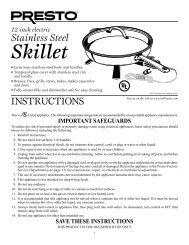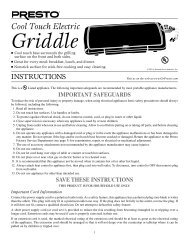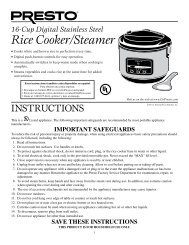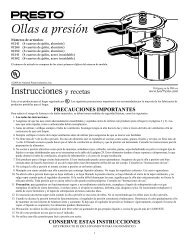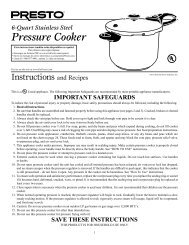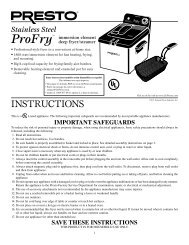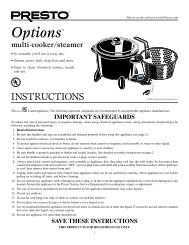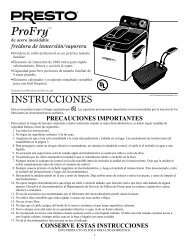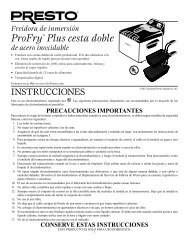You also want an ePaper? Increase the reach of your titles
YUMPU automatically turns print PDFs into web optimized ePapers that Google loves.
overpressure plug is a secondary pressure relief valve which<br />
is designed to relieve excess pressure by releasing from the<br />
cooker cover in the event that the vent pipe becomes blocked.<br />
The overpressure plug is made of rubber, and when new, is<br />
soft and pliable. Over time, depending on the frequency and<br />
type of use, rubber becomes hard and inflexible. When hard<br />
and inflexible, the overpressure plug loses its ability to act<br />
as a secondary pressure relief valve. It should be replaced<br />
immediately.<br />
Should the overpressure plug ever be forced out of the cover<br />
due to excess pressure while cooking, it is important to call<br />
the Test Kitchen at 1-800-368-2194. Do not attempt to use<br />
the released overpressure plug.<br />
7. Always follow special procedures found in the instruction<br />
book when pressure cooking rice, grains, and dry beans<br />
and peas. — During cooking, dry beans and peas tend to froth<br />
and foam which could cause the vent pipe to become blocked.<br />
Therefore, dry beans and peas need to be soaked and cooked<br />
according to instructions beginning on page 52. Using this<br />
method will keep foam at safe levels during cooking. Like dry<br />
beans and peas, rice and grains tend to froth and foam during<br />
cooking; therefore, to contain foaming and frothing during the<br />
cooking period, rice and grains must be prepared in a bowl in<br />
the pressure cooker according to directions on page 55.<br />
8. Never pressure cook applesauce, cranberries, rhubarb,<br />
cereals, pastas, dried soup mixes, or dry beans and peas<br />
which are not listed in the chart on page 53. — These foods<br />
expand so much as a result of foaming and frothing that they<br />
should never be cooked under pressure.<br />
Cleaning<br />
1. Unplug Control Master ® heat control from wall outlet and<br />
then remove heat control from pressure cooker. Wipe heat<br />
control with a damp cloth. Do not immerse heat control or<br />
let it come in contact with any liquid.<br />
2. Before initial use and after each subsequent use, wash pressure<br />
cooker in hot, soapy water and rinse and dry thoroughly,<br />
When washing the cover, the sealing ring should always be<br />
removed to allow easy cleaning of the inside rim of the cover.<br />
The sealing ring should be washed in hot, sudsy water after<br />
each use.<br />
If food residue adheres to the pressure cooker body, clean with<br />
a stainless steel scouring pad, a nylon pad, or a non-abrasive<br />
powder cleanser, such as Bon ami* polishing cleanser or<br />
Cameo* copper, brass & porcelain cleaner. Do not use steel<br />
wool or cleaners with chlorine bleach.<br />
The pressure cooker may also be washed in an automatic dishwasher.<br />
When washing in a dishwasher, you must first remove<br />
the sealing ring and overpressure plug from the cover as these<br />
parts must be hand washed.<br />
Note: When washing in an automatic dishwasher the aluminum<br />
bottom of the pressure cooker will discolor.<br />
3. To be sure the vent pipe is clear, hold the cover up to the light<br />
and look through<br />
Fig. N<br />
the vent pipe.<br />
Clean it with a<br />
small brush or<br />
pipe cleaner if<br />
it is blocked or<br />
partially blocked<br />
(Fig. N). Also<br />
*Bon ami polishing cleanser is a registered trademark of Faultless Starch/Bon Ami Co.<br />
Cameo copper, brass & porcelain cleaner is a registered trademark of Church & Dwight Co., Inc.<br />
14 15




